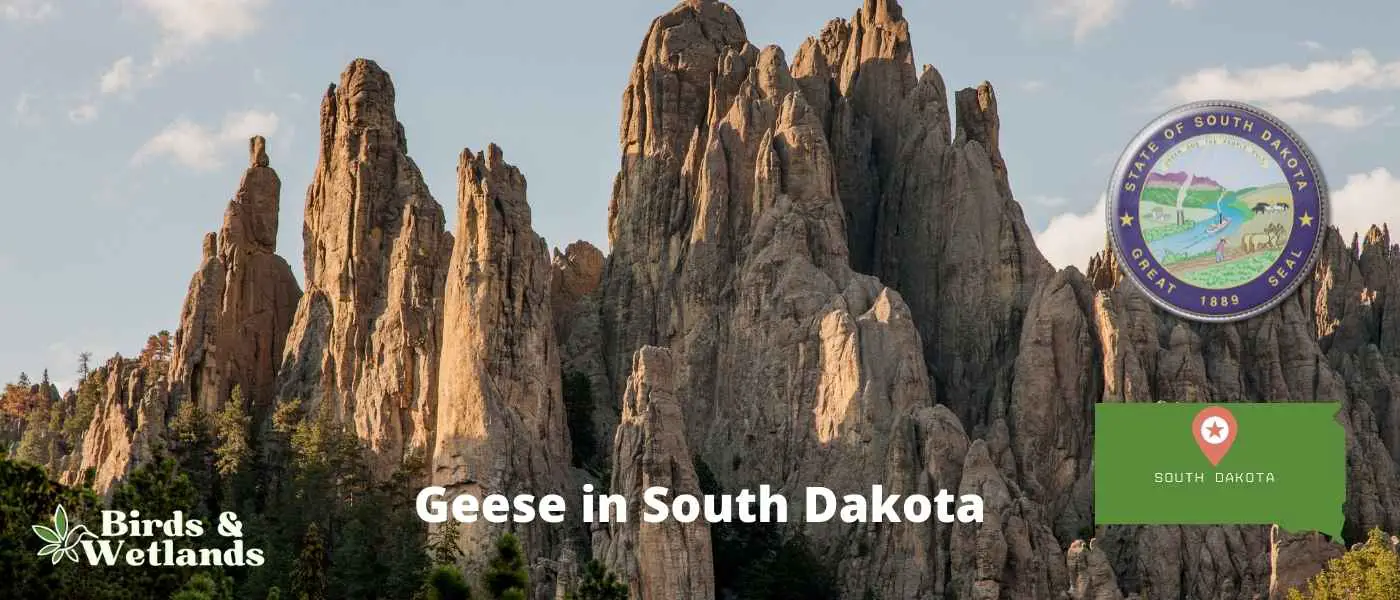It’s not often that you see a wild goose in South Dakota. In fact, many people are surprised to learn that geese even live in the state.
While the state doesn’t have the large populations of geese that are found in other states, there are still a few different types of geese that can be found in South Dakota.
What Geese Are in South Dakota?
There are six different types of geese in South Dakota.
- Canada Goose
- Snow Goose
- Ross’s Goose
- Cackling Goose
- Greater White-Fronted Goose
- Brant
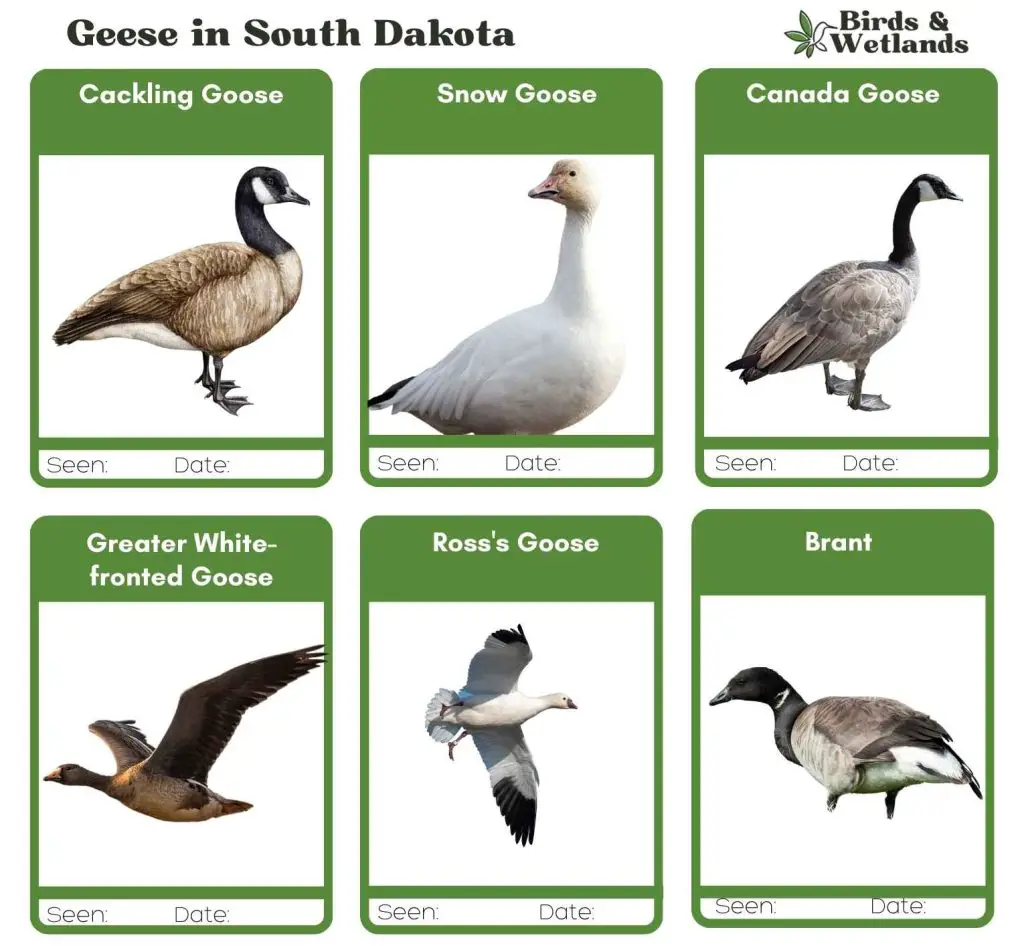
Canada Goose
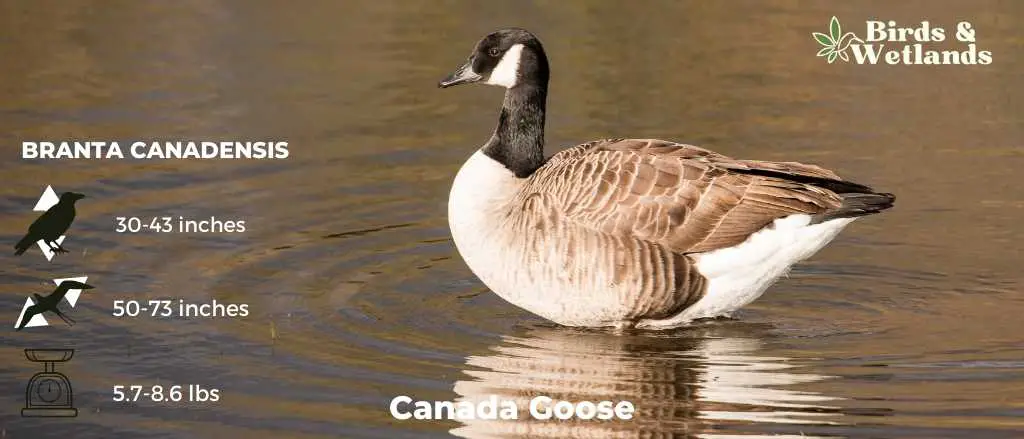
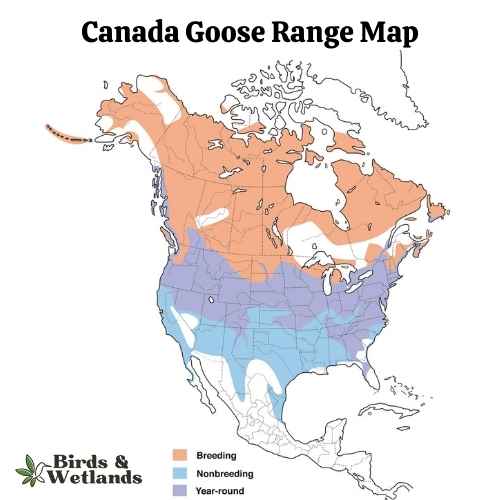
Canada Goose Sound
Scientific Name: Branta canadensis
Length: 30 to 43 in
Wingspan: 50–73 in
Weight: 5.7–14.3 lb
The Canada Goose is a large, well-known species of waterfowl noted for its distinctive appearance, familiar “honk,” and migratory behavior.
Appearance: Both male and female Canada Geese have a similar appearance, featuring a black head and neck with distinctive white patches on the cheeks and chin. The body is primarily brown with a lighter, often white, underbelly.
Diet: Canada Geese primarily feed on plant matter, including grasses, aquatic vegetation, and grains. They can often be seen grazing in parks, lawns, and fields, as well as dabbling in water bodies.
Reproduction: Canada Geese typically nest on the ground near water bodies, often on islands or other isolated areas to avoid predators. The female lays a clutch of about 4 to 6 eggs, which she incubates alone for around a month.
Snow Goose
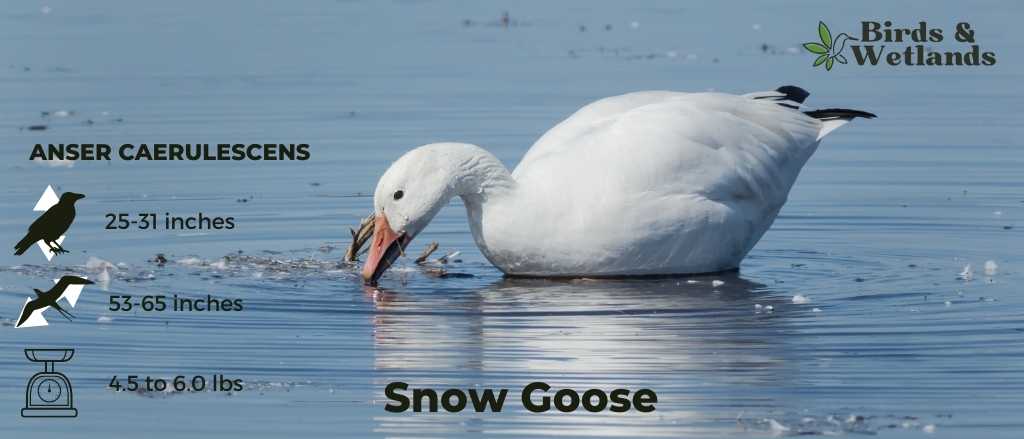
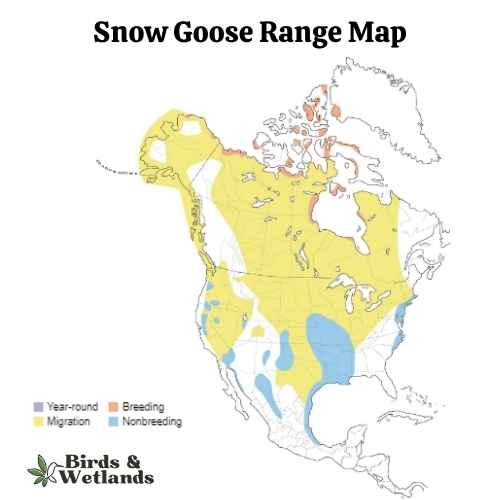
Snow Goose Sound
Scientific Name: Anser caerulescens
Length: 25 to 31 in
Wingspan: 53 to 65 in
Weight: 4.5 to 6.0
The Snow Goose is a large species of waterfowl known for its vibrant white plumage and significant migratory flights.
Appearance: True to their name, Snow Geese are predominantly white with black wingtips. They also have a pink bill, pink legs and feet. A color morph, known as the “Blue Goose,” displays a bluish-gray body with a white head, but is considered the same species.
Diet: Snow Geese primarily feed on plant matter, such as grasses, sedges, and small grains. They can often be seen in large flocks foraging in fields and marshes, and during migration and winter, they can cause considerable damage to agricultural fields due to their feeding habits.
Reproduction: Snow Geese typically nest on the tundra, near water bodies. The female builds the nest and lays a clutch of about 3 to 5 eggs, which she incubates alone for approximately three weeks. Once hatched, the goslings can feed themselves but stay with their parents for protection until they can fly.
Ross’s Goose
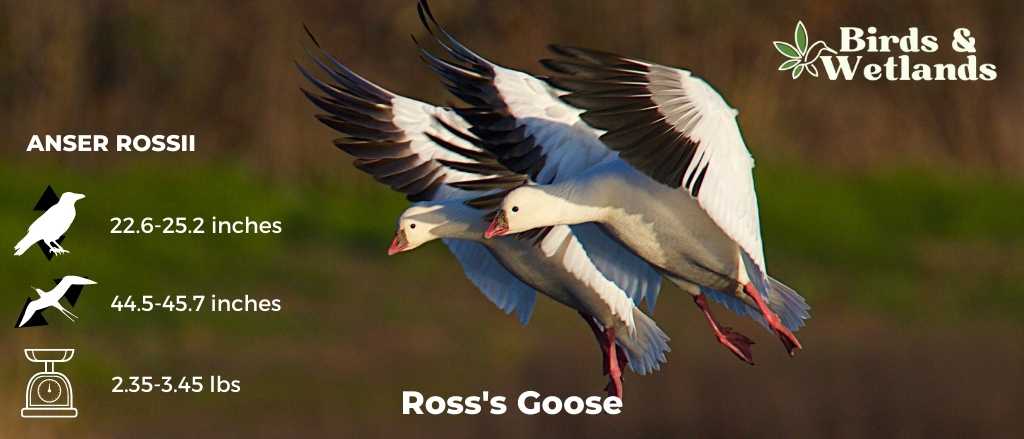
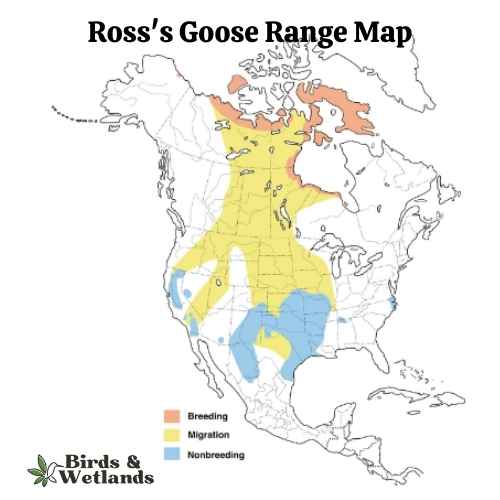
Listen
Scientific Name: Anser rossii
Length: 23.2-25.2
Wingspan: 44.5-45.7 in
Weight:42.3-55.3 oz
The Ross’s Goose is a small species of waterfowl often found in North America’s tundra and wetland habitats.
Appearance: Known for its compact size, the Ross’s Goose is mostly white with black wingtips. It features a short, stubby bill and a rounded head. One key identifying feature is the blueish gray base of its bill, which has a warty structure during the breeding season.
Diet: This goose feeds mainly on vegetation, including seeds, leaves, and roots of grasses and sedges. During winter and migration, they also consume grains and seeds from agricultural fields.
Reproduction: The Ross’s Goose nests on the ground, often in colonies. The female lays a clutch of 2 to 5 eggs which she incubates for around three weeks. The young geese, known as goslings, are precocial – they can walk, swim, and feed themselves shortly after hatching, although they stay with their parents until they learn to fly.
Cackling Goose
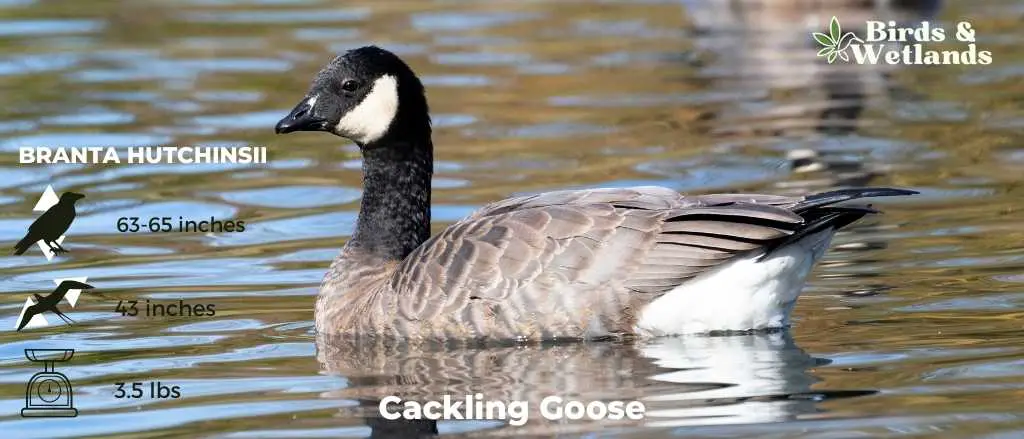
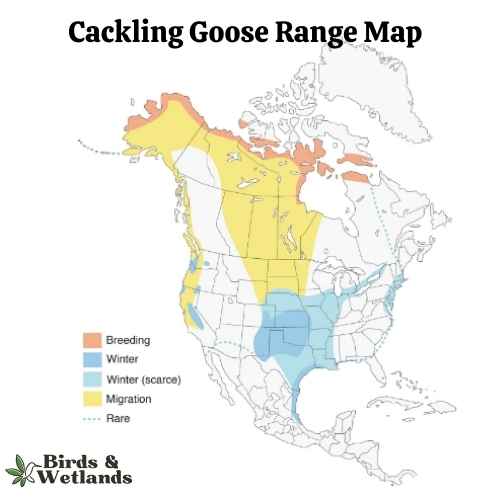
Listen
Scientific Name: Branta hutchinsii
Length: 24.8–25.6 in
Wingspan: 43-45.7 in
Weight:3.5 lbs
Cackling Geese are particularly known for their high-pitched, cackling calls, which is the source of their name. Despite their small size, these geese are renowned long-distance migrants, with some populations traveling thousands of miles between breeding and wintering grounds.
Appearance: With a similar color pattern to the larger Canada Goose, the Cackling Goose features a black head and neck, white chinstrap, light tan to cream chest, and brownish-grey body. One defining characteristic is its noticeably smaller size and stubbier neck compared to its larger counterparts.
Diet: Like many geese, the Cackling Goose’s diet mainly consists of plant matter. This includes grasses, seeds, and aquatic vegetation. They are often seen grazing on land or dabbling in shallow water.
Reproduction: Cackling Geese usually nest on the ground in elevated areas near water bodies, such as riverbanks or lakeshores. The female lays a clutch of 2 to 8 eggs and is responsible for incubation, while the male stands guard nearby. Incubation lasts for about a month.
Greater White-fronted Goose
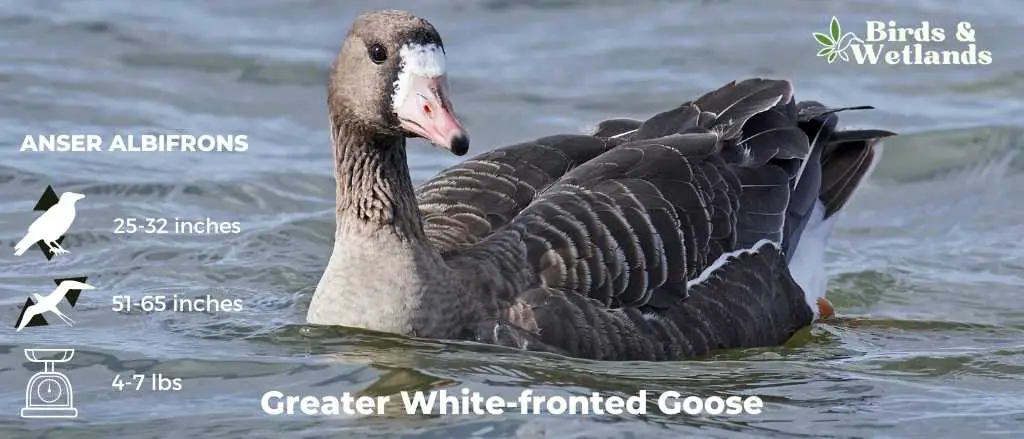
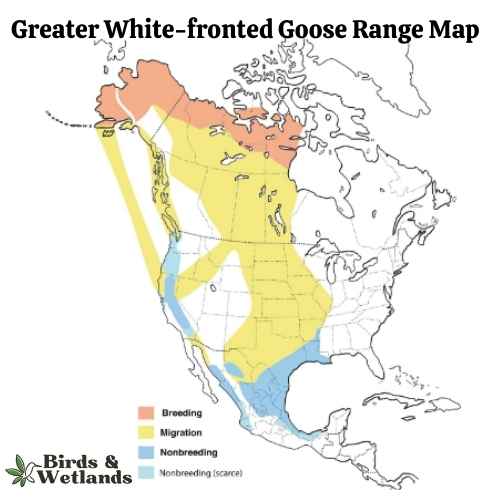
Listen
Scientific Name: Anser albifrons
Length: 25 to 31 in
Wingspan: 53 to 66 in
Weight: 3.3 to 6.6
The Greater White-fronted Goose is a medium to large waterfowl species, widely distributed across the Northern Hemisphere, particularly in North America.
Appearance: As the name suggests, these geese display a prominent white patch at the base of their bill. Their bodies are gray-brown, and their breasts are often marked with dark blotches. They possess a pinkish bill and orange legs and feet.
Diet: The Greater White-fronted Goose is a herbivore and feeds mainly on plant material. Its diet consists of grasses, sedges, grains, and berries. When wintering, these geese can often be found in agricultural fields, feasting on leftover grains and crops.
Reproduction: This species nests on the ground, often in areas with good visibility such as slopes or ridges. The female lays a clutch of 4 to 5 eggs, which she incubates for nearly a month. Once hatched, the young ones are taken care of by both parents until they are able to fly.
Brant
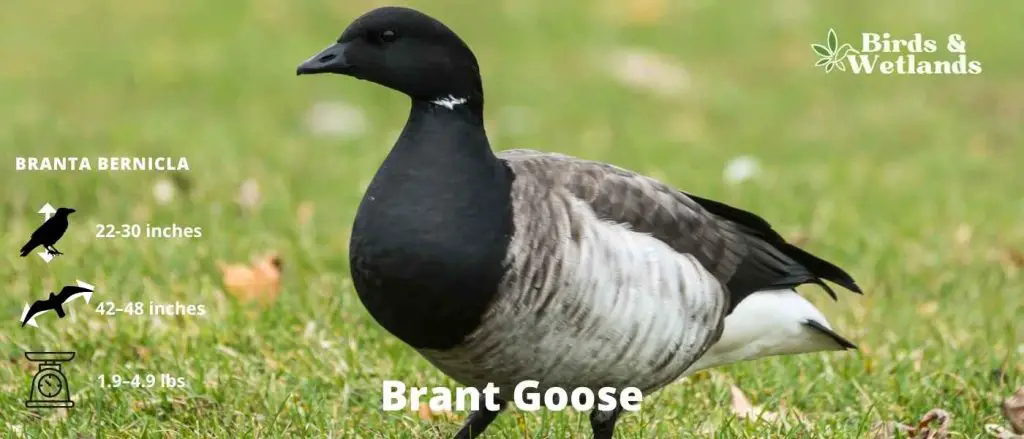
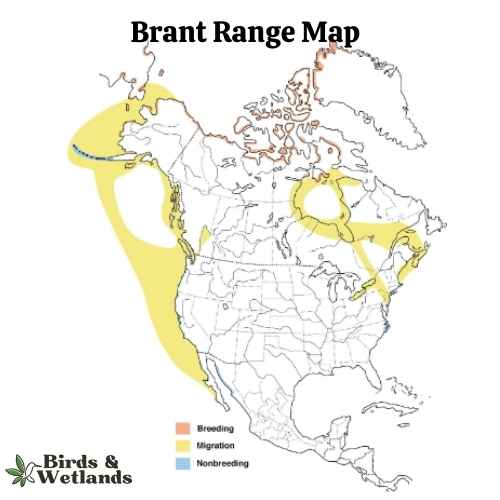
Listen
Scientific Name: Branta bernicla
Length: 22–26 in
Wingspan: 42–48 in
Weight: 1.9–4.9 lb
The Brant is a compact species of goose that is known for its striking appearance and interesting migratory patterns.
Appearance: The Brant is recognized for its dark, sooty color with a white crescent on the neck. The body is mostly black to dark gray, contrasting with the lighter underparts. Its small size, as compared to other geese, and short, stubby bill are other distinct features.
Diet: The Brant’s diet primarily consists of aquatic plants, especially eelgrass and sea lettuce. During the breeding season, they may also feed on grasses, sedges, and insects.
Reproduction: Brants typically breed in the high Arctic tundra. The female lays a clutch of 3 to 5 eggs in a ground nest, which she incubates for about a month.
Notably, Brants make an impressive long-distance migration every year. They spend their winters along both the east and west coasts of the United States and travel to the Arctic regions of Canada, Alaska, and even Russia to breed.
Are There Any Resident Flocks of Geese In South Dakota?
South Dakota is home to a variety of wildlife, including geese.
If you’re looking to see these majestic birds in their natural habitat, there are several great places to go.
Sand Lake National Wildlife Refuge is a popular spot for birdwatching, and it’s also a great place to learn about the different species of geese that call South Dakota home.
Lake Andes National Wildlife Refuge is another great place to see geese, and it also offers plenty of opportunities for hiking, biking, and fishing.
Oakwood Lakes State Park is another great option, and Waubay National Wildlife Refuge is a good choice if you’re looking to see a wider variety of birds. The Missouri River and Lake Preston are also great places to see geese, and they offer plenty of other outdoor activities as well.
Geese Hunting in South Dakota
Goose hunting is regulated by the federal government, and each state has its own laws and regulations. In general, goose hunting seasons are set in early spring, and hunters must obtain a license before they can pursue these birds.
In some states, such as South Dakota, nonresident licenses are limited in number and issued through an application process and lottery drawing.
As a result, hunters who are interested in goose hunting in South Dakota should plan ahead and be prepared to apply for a license well in advance of the season.
South Dakota also has a Spring Snow Goose Hunting which usually takes place from March to April, which is the spring snow goose season. If you want to participate in the South Dakota snow goose hunt, make sure you have the proper permits, stamps and licenses for the spring snow goose hunt.
Can You Shoot a Goose in South Dakota?
South Dakota is popular for its spring snow goose hunts. During spring migration, the spring snow geese population increases and you will know that the snow goose hunt is on. They also have a Light Goose Conservation Order which takes place from February to May.
In South Dakota, you are able to shoot geese with the state and federal regulations that are in place. The state regulations allow for the use of a shotgun with a maximum of three shells, and you are also able to use a bow and arrow. The federal regulations state that you can only hunt with equipment that is approved by the United States Fish and Wildlife Service.
The goose hunting season in South Dakota usually starts in September and ends in January. The daily limit is three and the possession limit is three times the bag limit.
Where Can I Hunt Geese in South Dakota?
South Dakota is a top destination for goose hunting, and there are a few prime spots to target.
Lake Thompson is a large body of water in the northeast corner of the state that’s bordered by fields—it’s a perfect place to set up a blind and wait for geese to fly in.
The Missouri River runs through the middle of South Dakota, and there are several good spots along its banks to hunt geese. In particular, look for areas where the river has cut through bluffs—these offer great vantage points for calling and decoying geese in from long distances.
Conclusion on Geese in the State of South Dakota
If you’re looking for an amazing wildlife experience, be sure to check out South Dakota. There are six different types of geese in the state, and they can be found in a variety of habitats. Whether you’re interested in watching them fly or want to see them up close, there’s a place for you to go!

